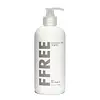What's inside
What's inside
 Key Ingredients
Key Ingredients

No key ingredients
 Benefits
Benefits

 Concerns
Concerns

 Ingredients Side-by-side
Ingredients Side-by-side

Water
Skin ConditioningSodium C14-16 Olefin Sulfonate
CleansingCocamide Mea
EmulsifyingCocamidopropyl Betaine
CleansingUrea
BufferingAvena Sativa Kernel Flour
AbrasiveAmodimethicone
Acrylates Copolymer
Piroctone Olamine
PreservativeAllantoin
Skin ConditioningHydroxypropyl Starch Phosphate
Guar Hydroxypropyltrimonium Chloride
Skin ConditioningCetrimonium Chloride
AntimicrobialTrideceth-12
EmulsifyingTrisodium Ethylenediamine Disuccinate
Phenoxyethanol
PreservativeCitric Acid
BufferingSodium Chloride
MaskingSodium Hydroxide
BufferingWater, Sodium C14-16 Olefin Sulfonate, Cocamide Mea, Cocamidopropyl Betaine, Urea, Avena Sativa Kernel Flour, Amodimethicone, Acrylates Copolymer, Piroctone Olamine, Allantoin, Hydroxypropyl Starch Phosphate, Guar Hydroxypropyltrimonium Chloride, Cetrimonium Chloride, Trideceth-12, Trisodium Ethylenediamine Disuccinate, Phenoxyethanol, Citric Acid, Sodium Chloride, Sodium Hydroxide
Ingredients Explained
These ingredients are found in both products.
Ingredients higher up in an ingredient list are typically present in a larger amount.
Cocamidopropyl Betaine is a fatty acid created by mixing similar compounds in coconut oil and dimethylaminopropylamine, a compound with two amino groups.
This ingredient is a surfactant and cleanser. It helps gather the dirt, pollutants, and other impurities in your skin to be washed away. It also helps thicken a product and make the texture more creamy.
Being created from coconut oil means Cocamidopropyl Betaine is hydrating for the skin.
While Cocamidopropyl Betaine was believed to be an allergen, a study from 2012 disproved this. It found two compounds in unpure Cocamidopropyl Betaine to be the irritants: aminoamide and 3-dimethylaminopropylamine. High-grade and pure Cocamidopropyl Betaine did not induce allergic reactions during this study.
Learn more about Cocamidopropyl BetainePhenoxyethanol is a preservative that has germicide, antimicrobial, and aromatic properties. Studies show that phenoxyethanol can prevent microbial growth. By itself, it has a scent that is similar to that of a rose.
It's often used in formulations along with Caprylyl Glycol to preserve the shelf life of products.
Water. It's the most common cosmetic ingredient of all. You'll usually see it at the top of ingredient lists, meaning that it makes up the largest part of the product.
So why is it so popular? Water most often acts as a solvent - this means that it helps dissolve other ingredients into the formulation.
You'll also recognize water as that liquid we all need to stay alive. If you see this, drink a glass of water. Stay hydrated!
Learn more about Water